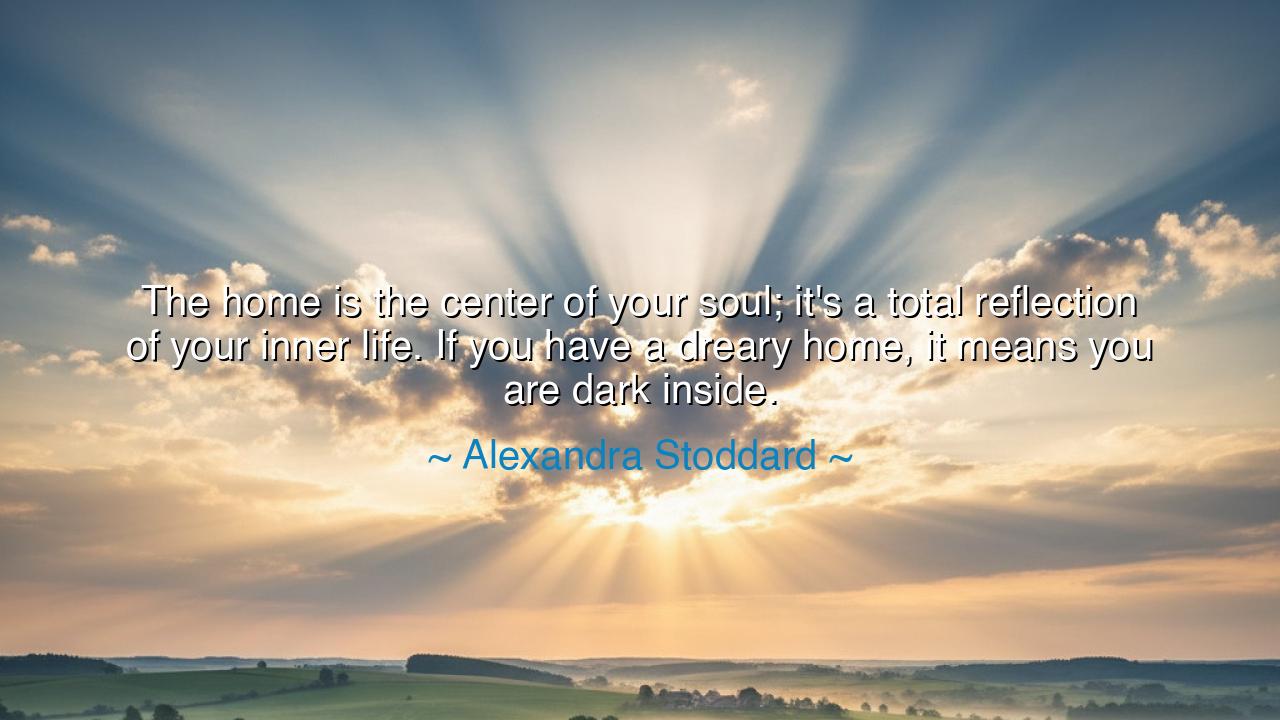
The home is the center of your soul; it's a total reflection of
The home is the center of your soul; it's a total reflection of your inner life. If you have a dreary home, it means you are dark inside.






The words of Alexandra Stoddard, “The home is the center of your soul; it's a total reflection of your inner life. If you have a dreary home, it means you are dark inside,” strike with the force of an ancient revelation. They remind us that the outer world we build is but the mirror of our inner being, that every object, color, and sound surrounding us carries the echo of our unseen spirit. In these words lies both a warning and a promise: that our homes, those sacred spaces where our souls dwell unseen by the crowd, tell the truth about who we truly are.
The home, to Stoddard, is not merely a place of shelter—it is the altar of the heart. In the ancient world, the hearth was sacred; to the Greeks, it was guarded by the goddess Hestia, symbol of warmth, unity, and devotion. The Romans kept the lares and penates, household gods that watched over the well-being of the family. They believed that to neglect the home’s spirit was to invite disorder into the soul. Stoddard’s words, though modern in sound, are born of that same eternal wisdom: when the home loses light, the heart has lost it first.
To say that one’s home reflects one’s inner life is to affirm the bond between body and spirit, between environment and emotion. A room filled with dust, clutter, or coldness speaks of weariness, confusion, or neglect within. But a space of order, of color, of light, reveals vitality, peace, and love. The walls of one’s dwelling are silent witnesses to one’s state of being. Every lamp unlit, every window closed, every barren corner whispers of the forgotten self. To cleanse the home is not only to polish its surfaces but to purify the soul.
History too bears witness to this truth. The great artist Leonardo da Vinci was known not only for his inventions and paintings but for the beauty and serenity of his workshop. His tools were arranged with precision, his surroundings infused with light. Those who visited him spoke of a calm energy, a sense that creativity lived in every inch of the space. In contrast, the writer Charles Baudelaire, tormented by melancholy, lived amid chaos—piles of books, torn papers, dim light. His room reflected the storms of his mind. Thus we see that environment and spirit are bound by invisible threads; to tend one is to tend the other.
But the wisdom of Stoddard’s quote reaches beyond decoration—it calls us to inner transformation. To make one’s home beautiful is not about luxury or ornament; it is about alignment. The soft glow of a candle, the presence of a flower, the sound of gentle music—these are offerings to the spirit, gestures of self-respect. When we honor our space, we declare that our lives are worthy of care and harmony. When we neglect it, we admit to a kind of inner poverty, a dimming of the soul’s flame.
Therefore, the lesson is clear: to heal the spirit, begin by healing the home. Open the windows to let in light; remove what no longer serves you; fill the air with beauty, scent, and peace. Each act of care—each bed made, each corner tended—becomes a ritual of renewal. The ancients knew this truth well: as within, so without; as without, so within. When the home glows with warmth, the heart follows; when the heart is alive, the home becomes a sanctuary.
And so, dear seeker of harmony, let your home become the reflection of your soul’s radiance. If darkness has crept into your dwelling, do not despair—cleanse it with intention, fill it with laughter, bless it with love. Remember always that every space you shape shapes you in return. The home is the center of your soul—guard it as you would guard the flame of life itself. For a bright home births a bright heart, and from such a heart, the whole world is illumined.






AAdministratorAdministrator
Welcome, honored guests. Please leave a comment, we will respond soon